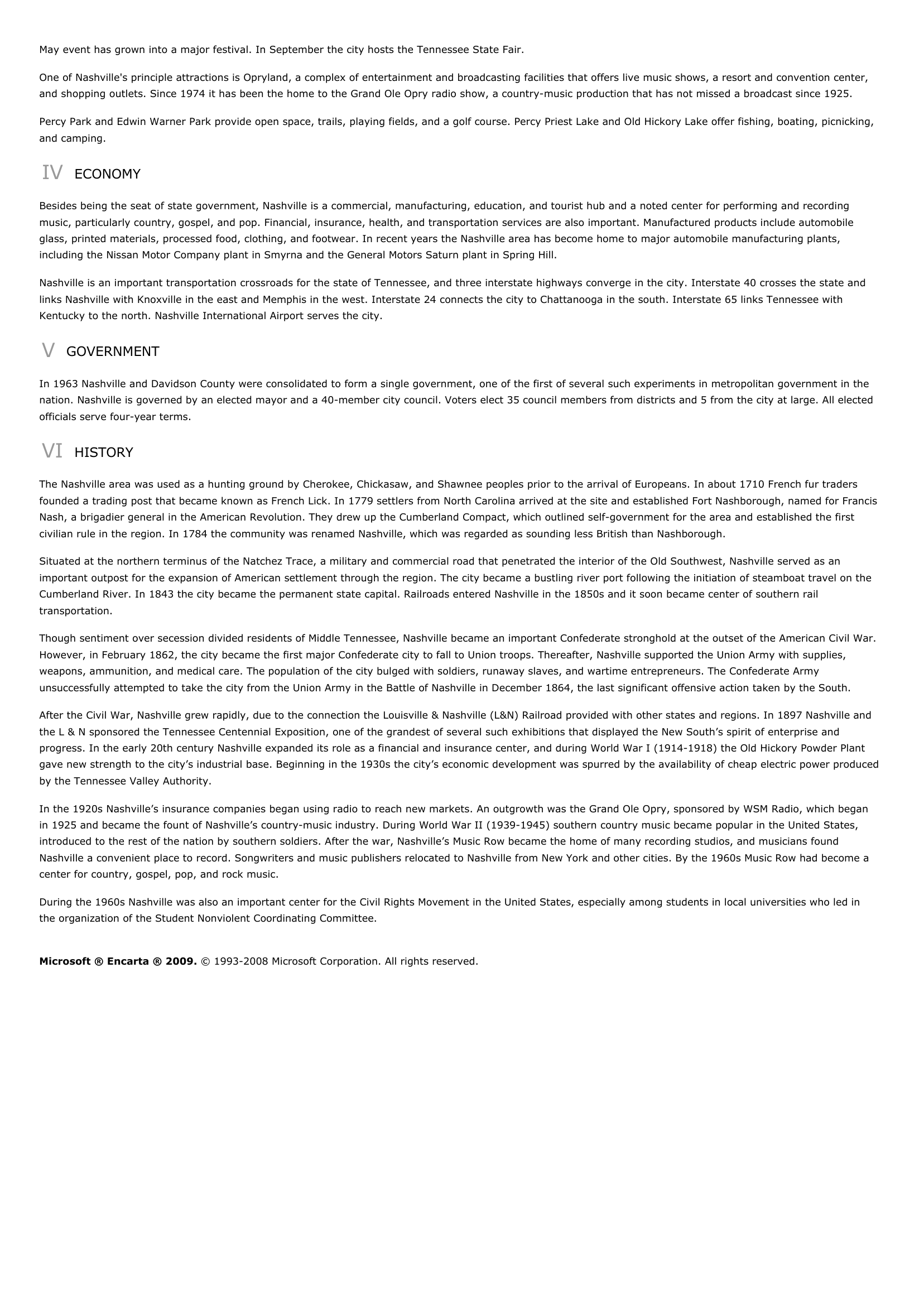Nashville - geography.
Publié le 04/05/2013

Extrait du document
«
May event has grown into a major festival.
In September the city hosts the Tennessee State Fair.
One of Nashville's principle attractions is Opryland, a complex of entertainment and broadcasting facilities that offers live music shows, a resort and convention center,and shopping outlets.
Since 1974 it has been the home to the Grand Ole Opry radio show, a country-music production that has not missed a broadcast since 1925.
Percy Park and Edwin Warner Park provide open space, trails, playing fields, and a golf course.
Percy Priest Lake and Old Hickory Lake offer fishing, boating, picnicking,and camping.
IV ECONOMY
Besides being the seat of state government, Nashville is a commercial, manufacturing, education, and tourist hub and a noted center for performing and recordingmusic, particularly country, gospel, and pop.
Financial, insurance, health, and transportation services are also important.
Manufactured products include automobileglass, printed materials, processed food, clothing, and footwear.
In recent years the Nashville area has become home to major automobile manufacturing plants,including the Nissan Motor Company plant in Smyrna and the General Motors Saturn plant in Spring Hill.
Nashville is an important transportation crossroads for the state of Tennessee, and three interstate highways converge in the city.
Interstate 40 crosses the state andlinks Nashville with Knoxville in the east and Memphis in the west.
Interstate 24 connects the city to Chattanooga in the south.
Interstate 65 links Tennessee withKentucky to the north.
Nashville International Airport serves the city.
V GOVERNMENT
In 1963 Nashville and Davidson County were consolidated to form a single government, one of the first of several such experiments in metropolitan government in thenation.
Nashville is governed by an elected mayor and a 40-member city council.
Voters elect 35 council members from districts and 5 from the city at large.
All electedofficials serve four-year terms.
VI HISTORY
The Nashville area was used as a hunting ground by Cherokee, Chickasaw, and Shawnee peoples prior to the arrival of Europeans.
In about 1710 French fur tradersfounded a trading post that became known as French Lick.
In 1779 settlers from North Carolina arrived at the site and established Fort Nashborough, named for FrancisNash, a brigadier general in the American Revolution.
They drew up the Cumberland Compact, which outlined self-government for the area and established the firstcivilian rule in the region.
In 1784 the community was renamed Nashville, which was regarded as sounding less British than Nashborough.
Situated at the northern terminus of the Natchez Trace, a military and commercial road that penetrated the interior of the Old Southwest, Nashville served as animportant outpost for the expansion of American settlement through the region.
The city became a bustling river port following the initiation of steamboat travel on theCumberland River.
In 1843 the city became the permanent state capital.
Railroads entered Nashville in the 1850s and it soon became center of southern railtransportation.
Though sentiment over secession divided residents of Middle Tennessee, Nashville became an important Confederate stronghold at the outset of the American Civil War.However, in February 1862, the city became the first major Confederate city to fall to Union troops.
Thereafter, Nashville supported the Union Army with supplies,weapons, ammunition, and medical care.
The population of the city bulged with soldiers, runaway slaves, and wartime entrepreneurs.
The Confederate Armyunsuccessfully attempted to take the city from the Union Army in the Battle of Nashville in December 1864, the last significant offensive action taken by the South.
After the Civil War, Nashville grew rapidly, due to the connection the Louisville & Nashville (L&N) Railroad provided with other states and regions.
In 1897 Nashville andthe L & N sponsored the Tennessee Centennial Exposition, one of the grandest of several such exhibitions that displayed the New South’s spirit of enterprise andprogress.
In the early 20th century Nashville expanded its role as a financial and insurance center, and during World War I (1914-1918) the Old Hickory Powder Plantgave new strength to the city’s industrial base.
Beginning in the 1930s the city’s economic development was spurred by the availability of cheap electric power producedby the Tennessee Valley Authority.
In the 1920s Nashville’s insurance companies began using radio to reach new markets.
An outgrowth was the Grand Ole Opry, sponsored by WSM Radio, which beganin 1925 and became the fount of Nashville’s country-music industry.
During World War II (1939-1945) southern country music became popular in the United States,introduced to the rest of the nation by southern soldiers.
After the war, Nashville’s Music Row became the home of many recording studios, and musicians foundNashville a convenient place to record.
Songwriters and music publishers relocated to Nashville from New York and other cities.
By the 1960s Music Row had become acenter for country, gospel, pop, and rock music.
During the 1960s Nashville was also an important center for the Civil Rights Movement in the United States, especially among students in local universities who led inthe organization of the Student Nonviolent Coordinating Committee.
Microsoft ® Encarta ® 2009. © 1993-2008 Microsoft Corporation.
All rights reserved..
»
↓↓↓ APERÇU DU DOCUMENT ↓↓↓
Liens utiles
- Nashville - geography.
- Shapley Harlow, 1885-1972, né à Nashville (Missouri), astronome américain.
- Ryman Robert, né en 1930 à Nashville (Tennessee), peintre américain.
- McCoy Horace, 1897-1955, né à Nashville (Tennessee), écrivain américain.
- Tokyo - geography.









